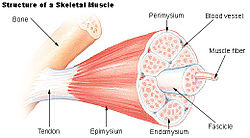| Epimysium | |
|---|---|
 Structure of a
skeletal muscle (epimysium labeled at bottom center) | |
| Details | |
| Location | Skeletal muscle |
| Identifiers | |
| TA98 | A04.0.00.041 |
| TA2 | 2009 |
| TH | H3.03.00.0.00006 |
| FMA | 9726 |
| Anatomical terminology | |
Epimysium ( plural epimysia [1]) (Greek epi- for on, upon, or above + Greek mys for muscle) is the fibrous tissue envelope that surrounds skeletal muscle. [2] It is a layer of dense irregular connective tissue which ensheaths the entire muscle and protects muscles from friction against other muscles and bones. [3] It also allows a muscle to contract and move powerfully while maintaining its structural integrity. [4]
It is continuous with fascia and other connective tissue wrappings of muscle including the endomysium and perimysium. It is also continuous with tendons, where it becomes thicker and collagenous.
While the epimysium is irregular on muscles, it is regular on tendons.
See also
References
- ^ "Definition of "Epimysia" from thefreedictionary.com". Retrieved 2008-05-29.
- ^ "Definition of epimysium on the Merriam-Webster Dictionary". The Merriam-Webster Dictionary. Retrieved 29 July 2015.
- ^ McCracken, Thomas (1999). New Atlas of Human Anatomy. China: Metro Books. pp. 1–120. ISBN 1-5866-3097-0.
-
^
 This article incorporates
text available under the
CC BY 4.0 license. Betts, J Gordon; Desaix, Peter; Johnson, Eddie; Johnson, Jody E; Korol, Oksana; Kruse, Dean; Poe, Brandon; Wise, James; Womble, Mark D; Young, Kelly A (June 7, 2023). Anatomy & Physiology. Houston: OpenStax CNX. 10.2 Skeletal muscle.
ISBN
978-1-947172-04-3.
This article incorporates
text available under the
CC BY 4.0 license. Betts, J Gordon; Desaix, Peter; Johnson, Eddie; Johnson, Jody E; Korol, Oksana; Kruse, Dean; Poe, Brandon; Wise, James; Womble, Mark D; Young, Kelly A (June 7, 2023). Anatomy & Physiology. Houston: OpenStax CNX. 10.2 Skeletal muscle.
ISBN
978-1-947172-04-3.
| Epimysium | |
|---|---|
 Structure of a
skeletal muscle (epimysium labeled at bottom center) | |
| Details | |
| Location | Skeletal muscle |
| Identifiers | |
| TA98 | A04.0.00.041 |
| TA2 | 2009 |
| TH | H3.03.00.0.00006 |
| FMA | 9726 |
| Anatomical terminology | |
Epimysium ( plural epimysia [1]) (Greek epi- for on, upon, or above + Greek mys for muscle) is the fibrous tissue envelope that surrounds skeletal muscle. [2] It is a layer of dense irregular connective tissue which ensheaths the entire muscle and protects muscles from friction against other muscles and bones. [3] It also allows a muscle to contract and move powerfully while maintaining its structural integrity. [4]
It is continuous with fascia and other connective tissue wrappings of muscle including the endomysium and perimysium. It is also continuous with tendons, where it becomes thicker and collagenous.
While the epimysium is irregular on muscles, it is regular on tendons.
See also
References
- ^ "Definition of "Epimysia" from thefreedictionary.com". Retrieved 2008-05-29.
- ^ "Definition of epimysium on the Merriam-Webster Dictionary". The Merriam-Webster Dictionary. Retrieved 29 July 2015.
- ^ McCracken, Thomas (1999). New Atlas of Human Anatomy. China: Metro Books. pp. 1–120. ISBN 1-5866-3097-0.
-
^
 This article incorporates
text available under the
CC BY 4.0 license. Betts, J Gordon; Desaix, Peter; Johnson, Eddie; Johnson, Jody E; Korol, Oksana; Kruse, Dean; Poe, Brandon; Wise, James; Womble, Mark D; Young, Kelly A (June 7, 2023). Anatomy & Physiology. Houston: OpenStax CNX. 10.2 Skeletal muscle.
ISBN
978-1-947172-04-3.
This article incorporates
text available under the
CC BY 4.0 license. Betts, J Gordon; Desaix, Peter; Johnson, Eddie; Johnson, Jody E; Korol, Oksana; Kruse, Dean; Poe, Brandon; Wise, James; Womble, Mark D; Young, Kelly A (June 7, 2023). Anatomy & Physiology. Houston: OpenStax CNX. 10.2 Skeletal muscle.
ISBN
978-1-947172-04-3.